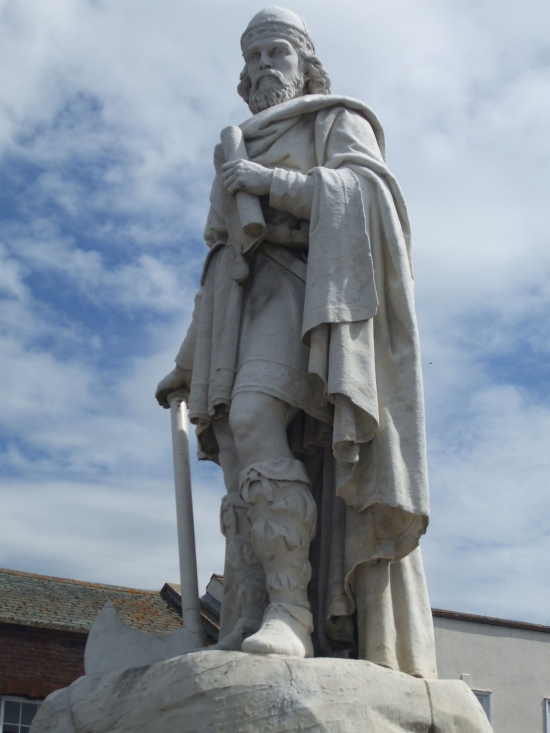 =
=
Many – or perhaps most – lovers of early medieval history will probably have heard of The Alfred Jewel. As a writer of novels set in the mid-late 9th century during the lifetime of Alfred the Great, it stands to reason that I should mention this fabulous jewel at some stage. That mention comes in the last chapter of the final book of the Sons of Kings series: King of the Anglo Saxons.

So what is this jewel, why it is of special interest and why it has been linked to King Alfred, shown in images below?


The Alfred Jewel is a rare and magnificent piece of filigreed gold enclosing a tear-shaped slice of clear quartz over a cloisonné* enamel plaque of green and blue. It is about 2.5 inches long and 1.2 inches wide, its purpose being to hold a pointer that could be attached to a page of a manuscript and moved down to facilitate reading of the text. Such implements were referred to aestels in Anglo-Saxon times. Several others have been found, all fabulous finds, but none as exquisite, or colourful, as the Alfred Jewel.
The image on the plaque of the Alfred Jewel is of a man with prominent eyes, holding two floriate stems. It could be a picture of Alfred himself, the pope, one of the saints, a figure of Sentient Man or Christ Incarnate. Modern thought favours the last two. The back of the enclosing gold is flattened for smooth sliding over a page (as with all aestels) and is decorated with an intricate design, thought to represent the Tree of Life.

The gold thickens at the base of the ‘tear-drop’ to become a dragon-like head. Inside the creature’s mouth is a cylindrical socket/hollow tube designed to hold a pointer. Most pointers were of wood but other materials were also used, notably ivory. The pointer was held in place by a rivet. Around the edge of the jewel is the inscription, ALFRED MEC HEHT GEWYRCAN, which means ‘Alfred ordered me to be made’.

The jewel was ploughed up in a field on land owned by Sir Thomas Wroth at North Pemberton in Somerset in 1693. The site is a mere eight miles from Athelney, where Alfred built his stronghold in order to defend his kingdom from Guthrum, and his invading Danes in 878 (Sons of Kings, Book 3, Wyvern of Wessex). We took his photo from an information board at Athelney:


The jewel was bequeathed to Oxford University by Sir Colonel Nathaniel Palmer (1661-1718) and today it is in the Ashmolean Museum in Oxford – where it has been described as ‘a matchless piece of goldsmith’s work’ by the British Archaeology Collection at the Ashmolean Museum
***
*Cloisonné is decorative work in which pieces of enamel, glass or gemstones are separated by strips of flattened wire placed edgeways on a metal body.




Interesting read. Can’t believe that those pieces are still in the archives.
Thanks, Ineke. Yes, the jewel is believed to date from the 9th century and after being buried until the 17th century, it’s in excellent condition.
Incredible.
What an extraordinary piece. Thanks for introducing it to me.
Thanks Peggy. Looking at photos of the Alfred Jewel, it’s hard to believe how small it actually is.
Ah, Millie – the Alfred Jewel has fascinated me ever since reading about it as a child. Seeing it up close and personal was a very special experience – it is exquisite. Thanks for this lovely reminder, and the additional details which I didn’t know. As for the story of Athelney, it is so much a part of the fabric of England – and, as you know, I enjoyed my visit! Btw – I’m sure Alfred’s Jewel influenced the wonderfully absurd and delightful ‘Detectorists’ series on TV.
Lucky you, Mike. I’d love to see the Alfred Jewel. Oddly enough, despite living so close to Oxford, we never visited the Ashmolean. I was too busy teaching and having children at the time (in no particular order) to go too far afield. We only went into Oxford for clothes shopping. Sad, eh…? 😀
Hello again Millie!! Wow!! thank you for sharing this with us! Fascinating pieces and history!!!
Hello Cybele! Thank you for commenting on my post. It seems so long since I chatted to you here on WP and it’s good to see your site is still going strong. After almost 3 years with hardly any posts, I’m struggling to resurrect mine. I agree, The Alfred Jewel is a fabulous and intricate piece, especially as it’s so tiny.
I’m not exactly prolific these days either lol!! Good to hear from you again.
Very interesting post, Millie! What a fascinating insight into material culture of the time. It would never occur to me to make up an object like that in my world-building — an exquisite and expensive piece of art whose only purpose is to point to a line of text while you read it. Talk about wealth display, wow! Truth really is odder than fiction sometimes.
Thanks, Joy. It’s an incredible piece and I agree, it does say a lot about the wealth of kings at the time, and their desire to flaunt it. Alfred was also very pious, hence the choice of image on the jewel. That the jewel was found in the 17th century is amazing in itself, as it was found close to where Alfred had a monastery built in the years following his time on Athelney (then an island in the middle of the Somerset fens).